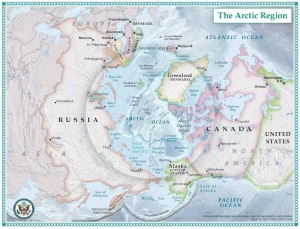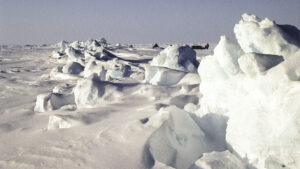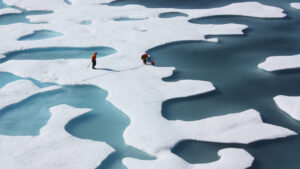By Mathieu Ardyna and Juliette Provencher, Laval University
Earlier this year our international team of scientists from the Refuge Arctic consortium departed Iqaluit in the Canadian territory of Nunavut on a 56-day research expedition in the far north. We were sailing aboard the icebreaker CCGS Amundsen and our main objective was to study the high latitudes of the Arctic Ocean.

The higher latitudes of the Arctic play a key role in the global climate and are home to many unique ecosystems linked to sea ice. Our destination was the evocatively named “last ice area,” a region in far northern Canada and Greenland.
Our icebreaker mission to northern latitudes of the last ice area allowed us to study many facets of this understudied region. Of particular interest were the properties of the sea ice, any physical and chemical gradients in the seawater, the distribution of contaminants such as mercury and microplastics, biodiversity and the marine food web.
The last ice area is projected to be the last area on Earth to experience permanent year-round sea ice. It is home to not only the thickest, and oldest, sea ice in the Arctic, but also to immense glaciers along the coasts. However, this region is increasingly subject to the multiple stresses of climate change, long-range pollution by contaminants and increased shipping activity — including by tourist vessels.
The high Arctic area is already experiencing severe ice loss, and is predicted to become increasingly ice-free over the coming decades. This change will profoundly affect the life and ecosystems of the Arctic. It is therefore urgent to develop an improved understanding of the last ice area as a unique global heritage in the biosphere, and as a critically important Arctic refuge for ice-dependent species in the face of climate warming.
The Arctic
Sea ice is the foundation of the complex marine ecosystem of the Arctic and plays many important roles. Several habitat types are directly dependent on sea ice and current changes in its thickness and seasons have profound implications for the future of the overall ecosystem.

The drastic loss of sea ice to date is one of the most obvious manifestations of climate change in the Arctic Ocean. Our research expedition allowed us to collect ice cores from both new and old sea ice. These cores contain a wealth of information, and we are now analyzing individual layers in the ice to examine how contaminants, trace elements and microbes travel across the Arctic Ocean.
In addition to measurements in the offshore ocean, we also took rock, water and ice samples from a number of different fjords and coastal glaciers. In this high Arctic region, fjords with large glaciers are an important part of the coastal ecosystem. Glaciers are sentinels of environmental change and understanding them provides key insights into how this environment may adapt to a changing climate.
As climate change intensifies and glaciers melt faster, the inflow of fresh water into the fjords and ocean is increasing, and these land-sea transition zones are likely to change. An improved understanding of the continuum between glaciers, rivers and the ocean in the coastal margins of the last ice area is of critical importance.
Glaciers that end in the ocean are shrinking rapidly and slowly becoming entirely terrestrial. This sudden change from marine to terrestrial glaciers will have major impacts on land and in the sea, including by altering marine food webs.
Arctic interconnections

Many ecological aspects of the last ice area remain a mystery. For example, our team aims to shed further light on to what extent thinning sea ice, reduced snow cover and the increased presence of melt ponds may alter food webs.
Our observations of animals dwelling below the ice in the area revealed an unexpected biodiversity of filter-feeding species. This is surprising given the minimal algal production in the ice above. Such discoveries highlight the need for an improved understanding of how below-ice communities are linked to those in the water and ice above.
In spring, phytoplankton may develop in and around the ice and our analyses and modelling are helping to identify the importance of these sources of organic matter for animal communities dwelling on the ocean floor.
The last ice area is one of the few remaining regions for evaluating the role of multi-year sea ice in Arctic ecosystem structure and functioning. As such, our studies aim to provide an improved prediction of the future ecology of a transformed, less icy Arctic Ocean.
Urgent protections needed
The unique ecosystems and biodiversity of the last ice area are now under increasing stress from multiple threats including climate change. The establishment of marine protected areas is an urgent priority to minimize these threats.
A national marine conservation area, Tallurutiup Imanga, was established in the southern part of this area. Meanwhile, a large part of the most northern sector was provisionally declared the marine protected area Tuvaijuittuq.
These conservation regions have been established by the Canadian federal government in partnership with Inuit Indigenous organizations with the aim of protecting the unique ecological features of the area in the long-term.
Conservation efforts must continue to grow in the years to come as the Arctic heats up. We hope that our data will in time contribute to long-term conservation strategies for this vitally important part of the Arctic Ocean.![]()
Mathieu Ardyna is a researcher at International Research Laboratory Takuvik and Juliette Provencher is a research assistant at Refuge Arctic, both at Laval University (Université Laval).
This article is republished from The Conversation under a Creative Commons license. Read the original article. Banner Image: Sunset on the Chukchi Sea in the Arctic (NASA Goddard Space Flight Center, Public domain, via Wikimedia Commons).
Sign up for The Invading Sea newsletter by visiting here. To support The Invading Sea, click here to make a donation. If you are interested in submitting an opinion piece to The Invading Sea, email Editor Nathan Crabbe at ncrabbe@fau.edu.



